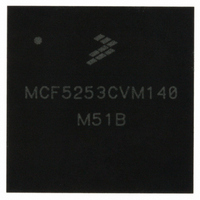MCF5253CVM140 Freescale Semiconductor, MCF5253CVM140 Datasheet - Page 408

MCF5253CVM140
Manufacturer Part Number
MCF5253CVM140
Description
IC MPU 32BIT 140MHZ 225-MAPBGA
Manufacturer
Freescale Semiconductor
Series
MCF525xr
Datasheets
1.MCF5253VM140J.pdf
(34 pages)
2.MCF5253VM140J.pdf
(8 pages)
3.MCF5253VM140J.pdf
(648 pages)
4.MCF5253VM140J.pdf
(2 pages)
Specifications of MCF5253CVM140
Core Processor
Coldfire V2
Core Size
32-Bit
Speed
140MHz
Connectivity
CAN, EBI/EMI, I²C, QSPI, UART/USART, USB OTG
Peripherals
DMA, WDT
Program Memory Type
ROMless
Ram Size
128K x 8
Voltage - Supply (vcc/vdd)
1.08 V ~ 1.32 V
Data Converters
A/D 6x12b
Oscillator Type
External
Operating Temperature
-40°C ~ 85°C
Package / Case
225-MAPBGA
Family Name
MCF5xxx
Device Core
ColdFire V2
Device Core Size
32b
Frequency (max)
140MHz
Instruction Set Architecture
RISC
Supply Voltage 1 (typ)
1.2/3.3V
Operating Supply Voltage (max)
1.32/3.6V
Operating Supply Voltage (min)
1.08/3V
Operating Temp Range
-40C to 85C
Operating Temperature Classification
Industrial
Mounting
Surface Mount
Pin Count
225
Package Type
MA-BGA
Lead Free Status / RoHS Status
Lead free / RoHS Compliant
Number Of I /o
-
Eeprom Size
-
Program Memory Size
-
Lead Free Status / Rohs Status
Compliant
Available stocks
Company
Part Number
Manufacturer
Quantity
Price
Company:
Part Number:
MCF5253CVM140
Manufacturer:
FREESCALE
Quantity:
300
Company:
Part Number:
MCF5253CVM140
Manufacturer:
Freescale Semiconductor
Quantity:
10 000
Part Number:
MCF5253CVM140
Manufacturer:
FREESCALE
Quantity:
20 000
Company:
Part Number:
MCF5253CVM140J
Manufacturer:
Freescale Semiconductor
Quantity:
10 000
- MCF5253VM140J PDF datasheet
- MCF5253VM140J PDF datasheet #2
- MCF5253VM140J PDF datasheet #3
- MCF5253VM140J PDF datasheet #4
- Current page: 408 of 648
- Download datasheet (8Mb)
Background Debug Mode (BDM) Interface
20-38
12–11
Field
EMU
MAP
DDC
UHE
TRC
IPW
BTB
NPL
9–8
16
15
14
13
10
6
Table 20-22. Configuration/Status Register (CSR) Field Descriptions (continued)
If set, the Inhibit Processor Writes to Debug Registers bit inhibits any processor-initiated writes to the debug
module’s programming model registers. This bit can only be modified by commands from the external
development system.
If set, the Force Processor References in Emulator Mode bit forces the processor to map all references while
in emulator mode to a special address space, TT = $2, TM = $5 or $6. If cleared, all emulator-mode references
are mapped into supervisor code and data spaces.
If set, the Force Emulation Mode on Trace Exception bit forces the processor to enter emulator mode when a
trace exception occurs.
If set, the Force Emulation Mode bit forces the processor to begin execution in emulator mode. Refer to
Section 20.4.1.1, “Emulator Mode.”
The 2-bit Debug Data Control field provides configuration control for capturing operand data for display on the
DDATA port. The encoding is:
00 No operand data is displayed
01 Capture all M-Bus write data
10 Capture all M-Bus read data
11 Capture all M-Bus read and write data
In all cases, the DDATA port displays the number of bytes defined by the operand reference size. For example,
byte displays 8 bits, word displays 16 bits, and long displays 32 bits (one nibble at a time across multiple clock
cycles.) Refer to
The User Halt Enable bit selects the CPU privilege level required to execute the HALT instruction.
0 HALT is a privileged, supervisor-only instruction
1 HALT is a non-privileged, supervisor/user instruction
The 2-bit Branch Target Bytes field defines the number of bytes of branch target address to be displayed on
the DDATA outputs. The encoding is:
00 0 bytes
01 Lower two bytes of the target address
10 Lower three bytes of the target address
11 Entire four-byte target address
Refer to
If set, the Non-Pipelined Mode bit forces the processor core to operate in a nonpipeline mode of operation. In
this mode, the processor effectively executes a single instruction at a time with no overlap.
When operating in non-pipelined mode, performance is severely degraded. For the V3 design, operation in
this mode essentially adds 6 cycles to the execution time of each instruction. Given that the measured
Effective Cycles per Instruction for V3 is ~2 cycles/instruction, meaning performance in non-pipeline mode
would be ~8 cycles/instruction, or approximately 25% compared to the pipelined performance.
Regardless of the state of CSR[6], if a PC breakpoint is triggered, it is always reported before the instruction
with the breakpoint is executed. The occurrence of an address and/or data breakpoint trigger is imprecise in
normal pipeline operation. When operating in non-pipeline mode, these triggers are always reported before
the next instruction begins execution. In this mode, the trigger reporting can be considered to be precise.
As previously detailed, the occurrence of an address and/or data breakpoint should always happen before the
next instruction begins execution. Therefore the occurrence of the address/data breakpoints should be
guaranteed.
Section 20.2.1.5, “Begin Execution of Taken Branch (PST = $5).”
Section 20.2.1.7, “Begin Data Transfer (PST = $8–$B).”
MCF5253 Reference Manual, Rev. 1
Description
Freescale Semiconductor
Related parts for MCF5253CVM140
Image
Part Number
Description
Manufacturer
Datasheet
Request
R
Part Number:
Description:
Mcf5253 Coldfire? Microprocessor Data Sheet
Manufacturer:
Freescale Semiconductor, Inc
Datasheet:
Part Number:
Description:
Manufacturer:
Freescale Semiconductor, Inc
Datasheet:
Part Number:
Description:
Manufacturer:
Freescale Semiconductor, Inc
Datasheet:
Part Number:
Description:
Manufacturer:
Freescale Semiconductor, Inc
Datasheet:
Part Number:
Description:
Manufacturer:
Freescale Semiconductor, Inc
Datasheet:
Part Number:
Description:
Manufacturer:
Freescale Semiconductor, Inc
Datasheet:
Part Number:
Description:
Manufacturer:
Freescale Semiconductor, Inc
Datasheet:
Part Number:
Description:
Manufacturer:
Freescale Semiconductor, Inc
Datasheet:
Part Number:
Description:
Manufacturer:
Freescale Semiconductor, Inc
Datasheet:
Part Number:
Description:
Manufacturer:
Freescale Semiconductor, Inc
Datasheet:
Part Number:
Description:
Manufacturer:
Freescale Semiconductor, Inc
Datasheet:
Part Number:
Description:
Manufacturer:
Freescale Semiconductor, Inc
Datasheet:
Part Number:
Description:
Manufacturer:
Freescale Semiconductor, Inc
Datasheet:
Part Number:
Description:
Manufacturer:
Freescale Semiconductor, Inc
Datasheet:
Part Number:
Description:
Manufacturer:
Freescale Semiconductor, Inc
Datasheet:











